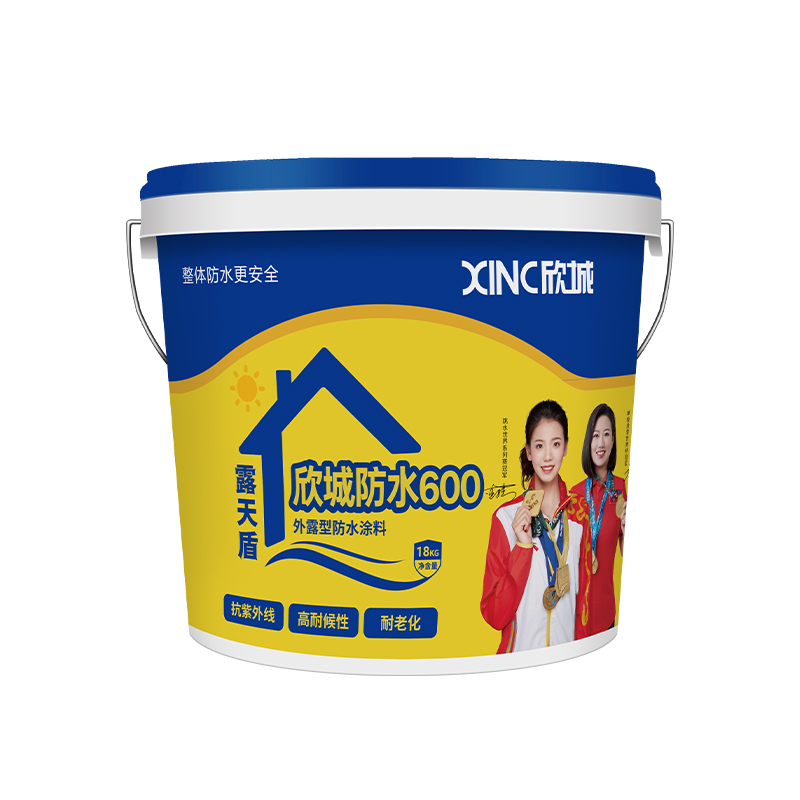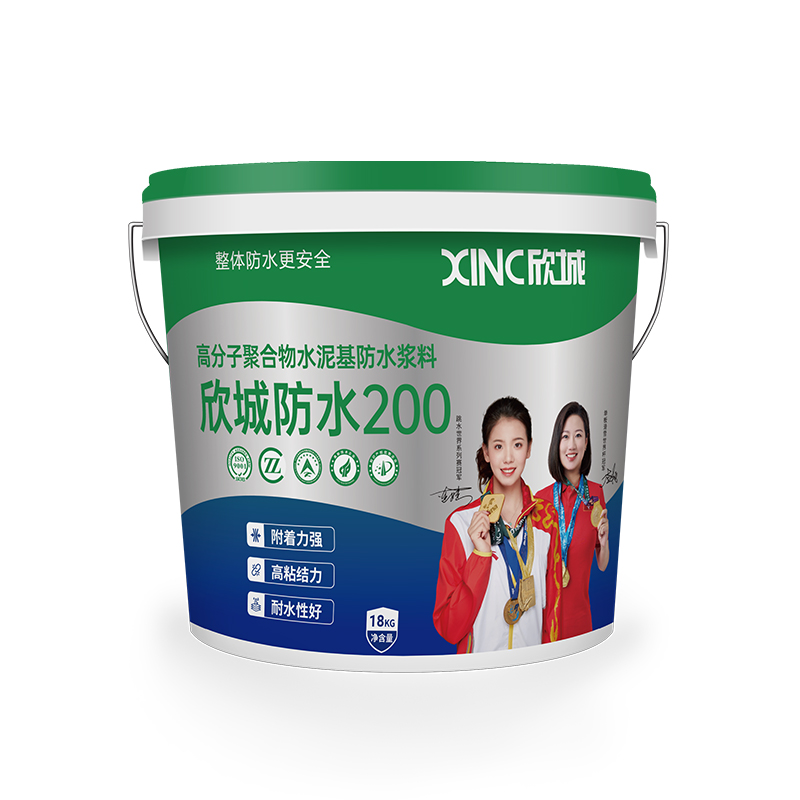How does polymer cement waterproof coating maintain its waterproof integrity even with tiny cracks in a building structure?
Release Time : 2025-11-03
Throughout a building's lifespan, the waterproof layer must not only resist external rainwater, groundwater, and daily water use, but also withstand the inevitable deformation and aging of the building structure itself. Concrete often develops tiny cracks under temperature changes, foundation settlement, or load. These imperceptible gaps are often the starting point for leaks. Traditional rigid waterproof materials lose their function once they crack, while polymer cement waterproof coating maintains its waterproof integrity even with micro-cracks due to its unique material composite mechanism, flexible adaptability, and deep synergistic effect with the substrate.
Polymer cement waterproof coating is essentially a composite system of organic and inorganic materials, with cement as the matrix and a modified system formed by adding high-molecular polymer emulsions. Cement provides rigid support and long-term stability, penetrating deep into the capillary pores of the substrate to form water-insoluble crystals, creating an "integrated" anchoring structure with the concrete. This chemical bonding force ensures the coating adheres firmly to the substrate, preventing peeling or flaking. The polymer component endows the coating with elasticity and ductility, making it less brittle than traditional cement-based materials and instead possessing a degree of flexibility. When micro-cracks appear in the substrate due to temperature changes or slight settlement, the coating does not immediately break but, through its own elastic deformation capacity, bridges the cracks and continues to cover the surface, maintaining the continuity of the waterproof barrier.
This "rigid-flexible" characteristic allows the coating to resist the penetration of external pressurized water while adapting to minor displacements of the internal structure. Cracks often appear before structural failure during propagation, and the elongation at break of the polymer cement coating is much higher than that of ordinary mortar. It can connect the two ends of the crack through tensile bridging in the early stages of crack opening, preventing water from penetrating deeper into the building. Even if the crack width increases slightly, the polymer chains within the coating can still maintain a certain sealing effect through intermolecular forces, delaying leakage. This "follow-the-leader" protection transforms the waterproof layer from a passively stressed weak link into an actively participating elastic member that coordinates structural deformation.
The coating's application method also enhances its ability to cope with cracks. Multiple coats are typically applied to form a uniform, seamless membrane. Reinforcing fabric or targeted treatment is added to stress-concentrated areas such as corners, pipe roots, and construction joints to enhance localized crack resistance. This continuous, seamless coverage avoids the leakage risks associated with traditional roll waterproofing materials due to poor overlap or edge lifting. Each layer of coating permeates the others, forming a dense, cross-linked network structure after curing, with extremely small internal pores that water molecules cannot easily penetrate.
Furthermore, the polymer cement coating possesses a certain degree of self-healing potential. In humid environments, incompletely hydrated cement particles may continue to react, generating new hydration products that fill tiny voids. Meanwhile, the polymer components maintain a certain degree of plastic flowability during long-term use, redistributing themselves at the edges of microcracks and slowing crack propagation. This slow self-regulating mechanism further extends the effective lifespan of the waterproofing layer.
More importantly, the adhesion between this coating and the substrate extends beyond the surface, penetrating deep into the concrete surface through capillary penetration, creating a seamless, integrated bond. When micro-cracks occur in a structure, the cracks tend to propagate along the interior of the concrete, rather than along the interface between the coating and the substrate. This means the waterproofing layer is not easily "torn apart." This deep interlocking relationship allows the coating to move with the substrate, rather than being peeled or torn.
In practical applications, polymer cement waterproof coating effectively addresses both early shrinkage cracks in new buildings and temperature-induced cracks in older structures. It doesn't aim to completely prevent cracks—which is inherently difficult to achieve in construction—but rather focuses on maintaining waterproofing even after cracks appear. This pragmatic yet intelligent protective concept makes it an ideal choice for crack-prone areas such as bathrooms, basements, balconies, and swimming pools.
In summary, the reason polymer cement waterproof coating can maintain waterproofing integrity even with micro-cracks in building structures is that it transcends the rigid limitations of traditional waterproofing materials, perfectly blending the durability of cement with the elasticity of polymers. It is not a cold barrier, but a protective layer with "life," understanding how to adapt to the structure's breathing and expansion, consistently upholding its waterproofing function amidst dynamic changes. In today's pursuit of building longevity and peace of mind for residents, this flexible yet steadfast protection is the most profound embodiment of modern waterproofing technology.
Polymer cement waterproof coating is essentially a composite system of organic and inorganic materials, with cement as the matrix and a modified system formed by adding high-molecular polymer emulsions. Cement provides rigid support and long-term stability, penetrating deep into the capillary pores of the substrate to form water-insoluble crystals, creating an "integrated" anchoring structure with the concrete. This chemical bonding force ensures the coating adheres firmly to the substrate, preventing peeling or flaking. The polymer component endows the coating with elasticity and ductility, making it less brittle than traditional cement-based materials and instead possessing a degree of flexibility. When micro-cracks appear in the substrate due to temperature changes or slight settlement, the coating does not immediately break but, through its own elastic deformation capacity, bridges the cracks and continues to cover the surface, maintaining the continuity of the waterproof barrier.
This "rigid-flexible" characteristic allows the coating to resist the penetration of external pressurized water while adapting to minor displacements of the internal structure. Cracks often appear before structural failure during propagation, and the elongation at break of the polymer cement coating is much higher than that of ordinary mortar. It can connect the two ends of the crack through tensile bridging in the early stages of crack opening, preventing water from penetrating deeper into the building. Even if the crack width increases slightly, the polymer chains within the coating can still maintain a certain sealing effect through intermolecular forces, delaying leakage. This "follow-the-leader" protection transforms the waterproof layer from a passively stressed weak link into an actively participating elastic member that coordinates structural deformation.
The coating's application method also enhances its ability to cope with cracks. Multiple coats are typically applied to form a uniform, seamless membrane. Reinforcing fabric or targeted treatment is added to stress-concentrated areas such as corners, pipe roots, and construction joints to enhance localized crack resistance. This continuous, seamless coverage avoids the leakage risks associated with traditional roll waterproofing materials due to poor overlap or edge lifting. Each layer of coating permeates the others, forming a dense, cross-linked network structure after curing, with extremely small internal pores that water molecules cannot easily penetrate.
Furthermore, the polymer cement coating possesses a certain degree of self-healing potential. In humid environments, incompletely hydrated cement particles may continue to react, generating new hydration products that fill tiny voids. Meanwhile, the polymer components maintain a certain degree of plastic flowability during long-term use, redistributing themselves at the edges of microcracks and slowing crack propagation. This slow self-regulating mechanism further extends the effective lifespan of the waterproofing layer.
More importantly, the adhesion between this coating and the substrate extends beyond the surface, penetrating deep into the concrete surface through capillary penetration, creating a seamless, integrated bond. When micro-cracks occur in a structure, the cracks tend to propagate along the interior of the concrete, rather than along the interface between the coating and the substrate. This means the waterproofing layer is not easily "torn apart." This deep interlocking relationship allows the coating to move with the substrate, rather than being peeled or torn.
In practical applications, polymer cement waterproof coating effectively addresses both early shrinkage cracks in new buildings and temperature-induced cracks in older structures. It doesn't aim to completely prevent cracks—which is inherently difficult to achieve in construction—but rather focuses on maintaining waterproofing even after cracks appear. This pragmatic yet intelligent protective concept makes it an ideal choice for crack-prone areas such as bathrooms, basements, balconies, and swimming pools.
In summary, the reason polymer cement waterproof coating can maintain waterproofing integrity even with micro-cracks in building structures is that it transcends the rigid limitations of traditional waterproofing materials, perfectly blending the durability of cement with the elasticity of polymers. It is not a cold barrier, but a protective layer with "life," understanding how to adapt to the structure's breathing and expansion, consistently upholding its waterproofing function amidst dynamic changes. In today's pursuit of building longevity and peace of mind for residents, this flexible yet steadfast protection is the most profound embodiment of modern waterproofing technology.







